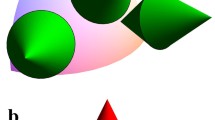Abstract
It is demonstrated that the notion of complementary physical quantities assumes the possibility of performing ideal first-kind measurements of such quantities. This then leads to an axiomatic reconstruction of the Hilbertian quantum theory based on the complementarity principle and on its connection with the measurement theoretical idealization known as the projection postulate. As the notion of complementary physical quantities does not presuppose the notion of probability, the given axiomatic reconstruction reveals complementarity as an essential reason for the irreducibly probabilistic nature of the quantum theory.
Similar content being viewed by others
References
Ali, S., and Emch, G. (1974). “Fuzzy Observables in Quantum Mechanics,”Journal of Mathematical Physics,15, 176–182.
Ali, S., and Prugovecki, E. (1977). “Systems of Imprimitivity and Representations of Quantum Mechanics on Fuzzy Phase Space,”Journal of Mathematical Physics,18, 219–228.
Beltrametti, E., and Cassinelli, G. (1981).The Logic of Quantum Mechanics, Addison-Wesley Publishing Company, Reading, Massachusetts.
Bohr, N. (1935). “Can Quantum-Mechanical Description of Physical Reality be Considered Complete?”Physical Review,48, 696–702.
Bugajska, K., and Bugajski, S. (1973a). “The Projection Postulate in Quantum Logic.”Bulletin de l' Academie Polonaise des Sciences, Serie des sciences math., astr. et phys. XXI, 873–877.
Bugajska, K., and Bugajski, S. (1973b). “The Lattice Structure of Quantum Logic,”Annales de l'Institut Henri Poincaré,XIX, 333–340.
Bugajski, S. (1981). “Two Questions on Quantum Mixtures,” a manuscript reported in the 14th Symposium on Mathematical Physics, Torun, December 8–11.
Bugajski, S., and Lahti, P. (1980). “Fundamental Principles of Quantum Theory,”International Journal of Theoretical Physics,29, 499–514.
Cassinelli, G., and Beltrametti, E. (1975). “Ideal, First-kind Measurements in a Proposition-State Structure,”Communications on Mathematical Physics,40, 7–13.
Davies, E. (1976).Quantum Theory of Open Systems, Academic Press, London.
Davies, E., and Lewis, J. (1970). “An Operational Approach to Quantum Probability,”Communications on Mathematical Physics,17, 239–260.
Dirac, P. (1958).The Principles of Quantum Mechanics, Oxford, Clarendon Press (First edition, 1930).
Edwards, C. (1970). “The Operational Approach to Quantum Probability,”Communications on Mathematical Physics,17, 239–260.
Fock, V. (1978).Fundamentals of Quantum Mechanics, Mir Publishers, Moscow.
Guz, W. (1981). “Conditional Probability and the Axiomatic Structure of Quantum Mechanics,”Fortschritte der Physik,29, 345–379.
Holevo, A. (1973). “Statistical Problems in Quantum Physics,”Lecture Notes in Mathematics,330, 104–119. Springer-Verlag, Berlin.
Ingarden, R. (1974).Information Theory and Thermodynamics, Part I, Chap. II,Quantum Theory. Reprint No. 275, Torun, Poland.
Jammer, M. (1974).The Philosophy of Quantum Mechanics, McGraw-Hill, New York.
Lahti, P. (1980). “Uncertainty and Complementarity in Axiomatic Quantum Mechanics,”International Journal of Theoretical Physics,19, 789–842.
Lahti, P. (1981a). “On the Inter-Relations of the Three Quantal Principles,” inCurrent Issues in Quantum Logic, Beltrametti, E., and van Fraassen, B. (eds.), Plenum Press, New York, pp. 447–454.
Lahti, P. (1981b). “On Uncertainty and Complementarity,” a manuscript reported in the 14th Symposium on Mathematical Physics, Torun, December 8–11.
Lahti, P. (1982). “A coherent superposition principle and the hilbertian quantum theory,”Reports on Mathematical Physics, in press.
Lahti, P., and Bugajski, S. (1981). “Fundamental Principles of Quantum Theory, II,” in preparation.
Mielnik, B. (1969). Theory of Filters,Communications on Mathematical Physics,15, 1–46.
Pauli, W. (1980).General Principles of Quantum Mechanics, Springer-Verlag, Berlin. (The original German edition in 1958).
Piron, C. (1976).Foundations of Quantum Physics, W. A. Benjamin, Inc., Reading, Massachusetts.
Primas, H. (1981).Chemistry, Quantum Mechanics and Reductionism, Lecture Notes in Chemistry,24, Springer-Verlag, Berlin.
Prugovecki, E. (1976). “Quantum Two-Particle Scattering in Fuzzy Phase Space,”Journal of Mathematical Physics,17, 1673–1681.
Scheibe, E. (1973).The Logical Analyses of Quantum Mechanics, Pergamon Press, Oxford.
Varadarajan, V. (1968).Geometry of Quantum Theory, I, Van Nostrand Reinhold Co., New York.
Author information
Authors and Affiliations
Additional information
On leave from: Department of Physical Sciences, University of Turku, SF-20500 Turku 50, Finland.
Rights and permissions
About this article
Cite this article
Lahti, P.J. Hilbertian quantum theory as the theory of complementarity. Int J Theor Phys 22, 911–929 (1983). https://doi.org/10.1007/BF02080476
Received:
Issue Date:
DOI: https://doi.org/10.1007/BF02080476




